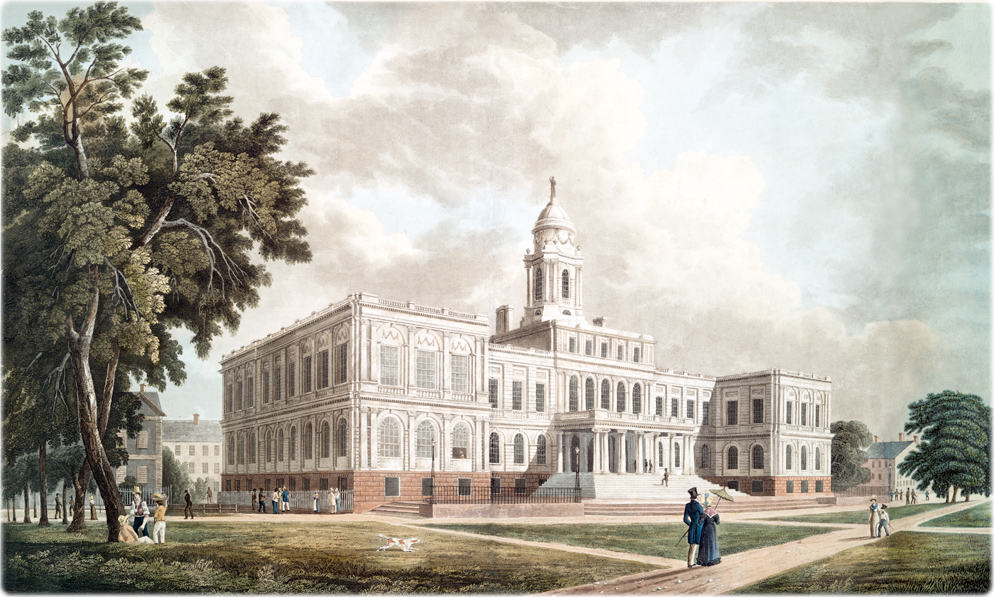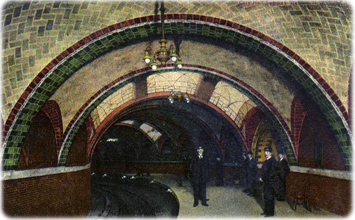
New York City Hall
Vintage Images
During the Dutch rule, a tavern, at the corner of Coenties Slip and Pearl Street, was converted into the first official City Hall (Stadt Huys). In 1674, the English took control of the city. The second City Hall was built on Wall Street between 1699 and 1700. It became the Federal Hall, when New York became the national capital, until 1790.
In 1802, the City of New York held a competition for a new City Hall building. The winning plan was designed by architects Joseph François Mangin, a French immigrant, and John McComb Jr., a New Yorker. The construction of the building started in May 1803, on the site of the old Poor House, demolished in 1897. The City Hall was dedicated in 1811 and completed in 1812, when the city government moved from the old Federal Hall.
The City Hall is a two-and-a-half-story building, 215 feet long by 105 feet deep. The height, including the attic, is 65 feet (about 100 feet if the cupola is included, without the statue). The south front and both ends above the basement were built of native white marble, and the rest of the building was constructed of brown freestone. The principal entrance, on the south front, is beneath a portico supported by Ionic columns, and reached by a flight of twelve marble steps. Five arched doors lead to a vestibule, whose vaulted ceiling is supported by square piers of marble. The chief offices were placed on this floor. The City Hall building originally housed the three wings of the city government: legislative, executive and judicial. The floor above was reached by three staircases, and housed the Common Council room, the Governor's room, the Comptroller's office, and the rooms in which the Court of Sessions, the District Court, the Mayor's Court, the Supreme Court, and the United States District Court were held.
The building also included wine and beer cellars, a chapel, small jails and a housekeeper's apartment. It was one of the finest architectural achievements of the period. The sculpture of Justice atop the building’s cupola is a copper replica of the original, which was carved in wood by John Dixey. The original figure held a builder’s steelyard balance instead of scales.
By the late 1840s a fire-bell structure was built on top of the roof, which was rung in the event of a fire. The original copper roof of City Hall was replaced in 1853. Pictorial analysis shows this fire-bell from 1848 (not before 1846) to 1858, when a fire destroyed the City Hall roof. Later, the bell system for fire alarm was replaced by street boxes and telegraphs.
In August 1858, the City Hall was partly destroyed by fire. The roof and cupola, with the first sculpture of Justice on top, were destroyed. The City Hall was rebuilt in the following months. Architects followed the design of the 1830 alteration of the cupola. The new clock tower was completed in April 1859, with a clock made by Sperry & Co. of New York. Its pendulum was over 14 feet long and the pendulum bob weighed over 300 pounds. In May 1860, a new wooden Justice sculpture was installed on the rebuilt cupola, but by 1887 it had deteriorated and had to be replaced. In 1917, the cupola burned again and its reconstruction was identical to the original McComb design (see the tower in 1900).
By 1889, some architects and politicians believed the City Hall was an old building, occupied too much space in the Park and should be demolished, but in 1894 the State of New York passed a law prohibiting the demolition of City Hall. The 25-story Municipal Building was constructed between 1909 and 1914, at the intersection of Chambers Street and Centre Street, facing City Hall Park.
The old City Hall has become a living museum and art gallery, home of more than 100 paintings by some of the leading late-18th to mid-19th-century artists. The building was designated a national historic landmark in 1960. The Landmarks Preservation Commission designated City Hall an individual landmark in 1966 and its central rotunda an interior landmark in 1976. In 1998, the roof and the domed tower were restored, replacing some deteriorated structure. More: City Hall Park in the 19th Century ►
New York City Hall, 1826, by William Guy Wall.
The old City Hall Subway Station in a vintage postcard.

|
Copyright © Geographic Guide - Old NYC, Historical Images. |
New York City Hall
